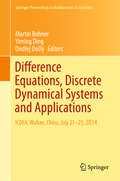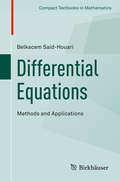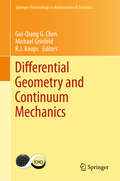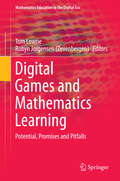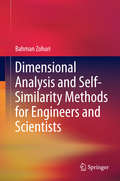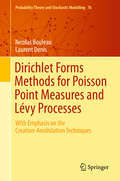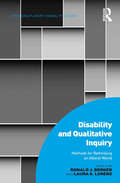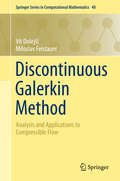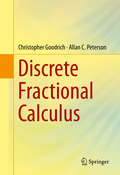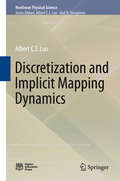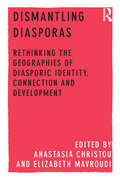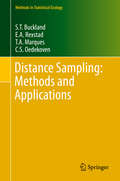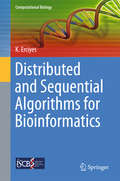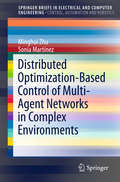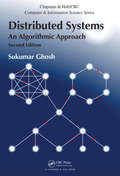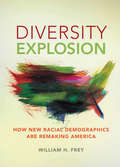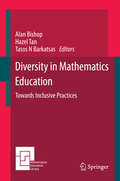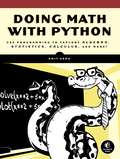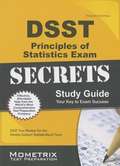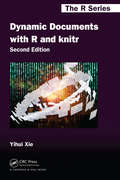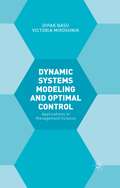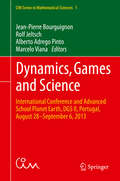- Table View
- List View
Difference Equations, Discrete Dynamical Systems and Applications
by Ondřej Došlý Yiming Ding Martin BohnerThese proceedings of the 20th International Conference on Difference Equations and Applications cover the areas of difference equations, discrete dynamical systems, fractal geometry, difference equations and biomedical models, and discrete models in the natural sciences, social sciences and engineering. The conference was held at the Wuhan Institute of Physics and Mathematics, Chinese Academy of Sciences (Hubei, China), under the auspices of the International Society of Difference Equations (ISDE) in July 2014. Its purpose was to bring together renowned researchers working actively in the respective fields, to discuss the latest developments, and to promote international cooperation on the theory and applications of difference equations. This book will appeal to researchers and scientists working in the fields of difference equations, discrete dynamical systems and their applications.
Differential Equations: Methods and Applications
by Belkacem Said-HouariThis book presents a variety of techniques for solving ordinary differential equations analytically and features a wealth of examples. Focusing on the modeling of real-world phenomena, it begins with a basic introduction to differential equations, followed by linear and nonlinear first order equations and a detailed treatment of the second order linear equations. After presenting solution methods for the Laplace transform and power series, it lastly presents systems of equations and offers an introduction to the stability theory. To help readers practice the theory covered, two types of exercises are provided: those that illustrate the general theory, and others designed to expand on the text material. Detailed solutions to all the exercises are included. The book is excellently suited for use as a textbook for an undergraduate class (of all disciplines) in ordinary differential equations.
Differential Geometry and Continuum Mechanics
by Gui-Qiang G. Chen Michael Grinfeld R. J. KnopsThis book examines the exciting interface between differential geometry and continuum mechanics, now recognised as being of increasing technological significance. Topics discussed include isometric embeddings in differential geometry and the relation with microstructure in nonlinear elasticity, the use of manifolds in the description of microstructure in continuum mechanics, experimental measurement of microstructure, defects, dislocations, surface energies, and nematic liquid crystals. Compensated compactness in partial differential equations is also treated. The volume is intended for specialists and non-specialists in pure and applied geometry, continuum mechanics, theoretical physics, materials and engineering sciences, and partial differential equations. It will also be of interest to postdoctoral scientists and advanced postgraduate research students. These proceedings include revised written versions of the majority of papers presented by leading experts at the ICMS Edinburgh Workshop on Differential Geometry and Continuum Mechanics held in June 2013. All papers have been peer reviewed.
Digital Games and Mathematics Learning
by Tom Lowrie Robyn JorgensenDigital games offer enormous potential for learning and engagement in mathematics ideas and processes. This volume offers multidisciplinary perspectives--of educators, cognitive scientists, psychologists and sociologists--on how digital games influence the social activities and mathematical ideas of learners/gamers. Contributing authors identify opportunities for broadening current understandings of how mathematical ideas are fostered (and embedded) within digital game environments. In particular, the volume advocates for new and different ways of thinking about mathematics in our digital age--proposing that these mathematical ideas and numeracy practices are distinct from new literacies or multiliteracies. The authors acknowledge that the promise of digital games has not always been realised/fulfilled. There is emerging, and considerable, evidence to suggest that traditional discipline boundaries restrict opportunities for mathematical learning. Throughout the book, what constitutes mathematics learnings and pedagogy is contested. Multidisciplinary viewpoints are used to describe and understand the potential of digital games for learning mathematics and identify current tensions within the field. Mathematics learning is defined as being about problem solving; engagement in mathematical ideas and processes; and social engagement. The artefact, which is the game, shapes the ways in which the gamers engage with the social activity of gaming. In parallel, the book (as a te xtual artefact) will be supported by Springer's online platform--allowing for video and digital communication (including links to relevant websites) to be used as supplementary material and establish a dynamic communication space.
Dimensional Analysis and Self-Similarity Methods for Engineers and Scientists
by Bahman ZohuriThis ground-breaking reference provides an overview of key concepts in dimensional analysis, and then pushes well beyond traditional applications in fluid mechanics to demonstrate how powerful this tool can be in solving complex problems across many diverse fields. Of particular interest is the book's coverage of dimensional analysis and self-similarity methods in nuclear and energy engineering. Numerous practical examples of dimensional problems are presented throughout, allowing readers to link the book's theoretical explanations and step-by-step mathematical solutions to practical implementations.
Dirichlet Forms Methods for Poisson Point Measures and Lévy Processes
by Laurent Denis Nicolas BouleauA simplified approach to Malliavin calculus adapted to Poisson random measures is developed and applied in this book. Called the "lent particle method" it is based on perturbation of the position of particles. Poisson random measures describe phenomena involving random jumps (for instance in mathematical finance) or the random distribution of particles (as in statistical physics). Thanks to the theory of Dirichlet forms, the authors develop a mathematical tool for a quite general class of random Poisson measures and significantly simplify computations of Malliavin matrices of Poisson functionals. The method gives rise to a new explicit calculus that they illustrate on various examples: it consists in adding a particle and then removing it after computing the gradient. Using this method, one can establish absolute continuity of Poisson functionals such as Lévy areas, solutions of SDEs driven by Poisson measure and, by iteration, obtain regularity of laws. The authors also give applications to error calculus theory. This book will be of interest to researchers and graduate students in the fields of stochastic analysis and finance, and in the domain of statistical physics. Professors preparing courses on these topics will also find it useful. The prerequisite is a knowledge of probability theory.
Disability and Qualitative Inquiry: Methods for Rethinking an Ableist World (Interdisciplinary Disability Studies)
by Ronald J. Berger Laura S. LorenzThis groundbreaking text makes an intervention on behalf of disability studies into the broad field of qualitative inquiry. Ronald Berger and Laura Lorenz introduce readers to a range of issues involved in doing qualitative research on disabilities by bringing together a collection of scholarly work that supplements their own contributions and covers a variety of qualitative methods: participant observation, interviewing and interview coding, focus groups, autoethnography, life history, narrative analysis, content analysis, and participatory visual methods. The chapters are framed in terms of the relevant methodological issues involved in the research, bringing in substantive findings to illustrate the fruits of the methods. In doing so, the book covers a range of physical, sensory, and cognitive impairments. This work resonates with themes in disability studies such as emancipatory research, which views research as a collaborative effort with research subjects whose lives are enhanced by the process and results of the work. It is a methodological approach that requires researchers to be on guard against exploiting informants for the purpose of professional aggrandizement and to engage in a process of ongoing self-reflection to clear themselves of personal and professional biases that may interfere with their ability to hear and empathize with others.
Discontinuous Galerkin Method
by Vít Dolejší Miloslav FeistauerThe subject of the book is the mathematical theory of the discontinuous Galerkin method (DGM), which is a relatively new technique for the numerical solution of partial differential equations. The book is concerned with the DGM developed for elliptic and parabolic equations and its applications to the numerical simulation of compressible flow. It deals with the theoretical as well as practical aspects of the DGM and treats the basic concepts and ideas of the DGM, as well as the latest significant findings and achievements in this area. The main benefit for readers and the book's uniqueness lie in the fact that it is sufficiently detailed, extensive and mathematically precise, while at the same time providing a comprehensible guide through a wide spectrum of discontinuous Galerkin techniques and a survey of the latest efficient, accurate and robust discontinuous Galerkin schemes for the solution of compressible flow.
Discovering Geometry
by Michael SerraThis text brings the subject to life with investigations, constructions, activities, and projects.
Discrete Fractional Calculus
by Christopher Goodrich Allan C. PetersonThis text provides the first comprehensive treatment of the discrete fractional calculus. Experienced researchers will find the text useful as a reference for discrete fractional calculus and topics of current interest. Students who are interested in learning about discrete fractional calculus will find this text to provide a useful starting point. Several exercises are offered at the end of each chapter and select answers have been provided at the end of the book. The presentation of the content is designed to give ample flexibility for potential use in a myriad of courses and for independent study. The novel approach taken by the authors includes a simultaneous treatment of the fractional- and integer-order difference calculus (on a variety of time scales, including both the usual forward and backwards difference operators). The reader will acquire a solid foundation in the classical topics of the discrete calculus while being introduced to exciting recent developments, bringing them to the frontiers of the subject. Most chapters may be covered or omitted, depending upon the background of the student. For example, the text may be used as a primary reference in an introductory course for difference equations which also includes discrete fractional calculus. Chapters 1--2 provide a basic introduction to the delta calculus including fractional calculus on the set of integers. For courses where students already have background in elementary real analysis, Chapters 1--2 may be covered quickly and readers may then skip to Chapters 6--7 which present some basic results in fractional boundary value problems (FBVPs). Chapters 6--7 in conjunction with some of the current literature listed in the Bibliography can provide a basis for a seminar in the current theory of FBVPs. For a two-semester course, Chapters 1--5 may be covered in depth, providing a very thorough introduction to both the discrete fractional calculus as well as the integer-order calculus.
Discretization and Implicit Mapping Dynamics
by Albert C. J. LuoThis unique book presents the discretization of continuous systems and implicit mapping dynamics of periodic motions to chaos in continuous nonlinear systems. The stability and bifurcation theory of fixed points in discrete nonlinear dynamical systems is reviewed, and the explicit and implicit maps of continuous dynamical systems are developed through the single-step and multi-step discretizations. The implicit dynamics of period-m solutions in discrete nonlinear systems are discussed. The book also offers a generalized approach to finding analytical and numerical solutions of stable and unstable periodic flows to chaos in nonlinear systems with/without time-delay. The bifurcation trees of periodic motions to chaos in the Duffing oscillator are shown as a sample problem, while the discrete Fourier series of periodic motions and chaos are also presented. The book offers a valuable resource for university students, professors, researchers and engineers in the fields of applied mathematics, physics, mechanics, control systems, and engineering.
Dismantling Diasporas: Rethinking the Geographies of Diasporic Identity, Connection and Development
by Anastasia Christou Elizabeth MavroudiRe-energising debates on the conceptualisation of diasporas in migration scholarship and in geography, this work stresses the important role that geographers can play in interrupting assumptions about the spaces and processes of diaspora. The intricate, material and complex ways in which those in diaspora contest, construct and perform identity, politics, development and place is explored throughout this book. The authors ’dismantle’ diasporas in order to re-theorise the concept through empirically grounded, cutting-edge global research. This innovative volume will appeal to an international and interdisciplinary audience in ethnic, migration and diaspora studies as it tackles comparative, multi-sited and multi-method research through compelling case studies in a variety of contexts spanning the Global North and South. The research in this book is guided by four interconnected themes: the ways in which diasporas are constructed and performed through identity, the body, everyday practice and place; how those in diaspora become politicised and how this leads to unities and disunities in relation to 'here' and 'there'; the ways in which diasporas seek to connect and re-connect with their 'homelands' and the consequences of this in terms of identity formation, employment and theorising who 'counts' as a diaspora; and how those in diaspora engage with homeland development and the challenges this creates.
Distance Sampling: Methods and Applications
by S. T. Buckland E. A. Rexstad T. A. Marques C. S. OedekovenIn this book, the authors cover the basic methods and advances within distance sampling that are most valuable to practitioners and in ecology more broadly. This is the fourth book dedicated to distance sampling. In the decade since the last book published, there have been a number of new developments. The intervening years have also shown which advances are of most use. This self-contained book covers topics from the previous publications, while also including recent developments in method, software and application. Distance sampling refers to a suite of methods, including line and point transect sampling, in which animal density or abundance is estimated from a sample of distances to detected individuals. The book illustrates these methods through case studies; data sets and computer code are supplied to readers through the book's accompanying website. Some of the case studies use the software Distance, while others use R code. The book is in three parts. The first part addresses basic methods, the design of surveys, distance sampling experiments, field methods and data issues. The second part develops a range of modelling approaches for distance sampling data. The third part describes variations in the basic method; discusses special issues that arise when sampling different taxa (songbirds, seabirds, cetaceans, primates, ungulates, butterflies, and plants); considers advances to deal with failures of the key assumptions; and provides a check-list for those conducting surveys.
Distributed and Sequential Algorithms for Bioinformatics
by K. ErciyesThis unique textbook/reference presents unified coverage of bioinformatics topics relating to both biological sequences and biological networks, providing an in-depth analysis of cutting-edge distributed algorithms, as well as of relevant sequential algorithms. In addition to introducing the latest algorithms in this area, more than fifteen new distributed algorithms are also proposed. Topics and features: reviews a range of open challenges in biological sequences and networks; describes in detail both sequential and parallel/distributed algorithms for each problem; suggests approaches for distributed algorithms as possible extensions to sequential algorithms, when the distributed algorithms for the topic are scarce; proposes a number of new distributed algorithms in each chapter, to serve as potential starting points for further research; concludes each chapter with self-test exercises, a summary of the key points, a comparison of the algorithms described, and a literature review.
Distributed Optimization-Based Control of Multi-Agent Networks in Complex Environments
by Minghui Zhu Sonia MartínezThis book offers a concise and in-depth exposition of specific algorithmic solutions for distributed optimization based control of multi-agent networks and their performance analysis. It synthesizes and analyzes distributed strategies for three collaborative tasks: distributed cooperative optimization, mobile sensor deployment and multi-vehicle formation control. The book integrates miscellaneous ideas and tools from dynamic systems, control theory, graph theory, optimization, game theory and Markov chains to address the particular challenges introduced by such complexities in the environment as topological dynamics, environmental uncertainties, and potential cyber-attack by human adversaries. The book is written for first- or second-year graduate students in a variety of engineering disciplines, including control, robotics, decision-making, optimization and algorithms and with backgrounds in aerospace engineering, computer science, electrical engineering, mechanical engineering and operations research. Researchers in these areas may also find the book useful as a reference.
Distributed Systems: An Algorithmic Approach, Second Edition (Chapman And Hall/crc Computer And Information Science Ser.)
by Sukumar GhoshDistributed Systems: An Algorithmic Approach, Second Edition provides a balanced and straightforward treatment of the underlying theory and practical applications of distributed computing. As in the previous version, the language is kept as unobscured as possible-clarity is given priority over mathematical formalism. This easily digestible text:Fea
Diversity Explosion
by William H. FreyAt its optimistic best, America has embraced its identity as the world's melting pot. Today it is on the cusp of becoming a country with no racial majority, and new minorities are poised to exert a profound impact on U.S. society, economy, and politics. The concept of a "minority white" may instill fear among some Americans, but William H. Frey, the man behind the demographic research, points out that demography is destiny, and the fear of a more racially diverse nation will almost certainly dissipate over time.Through a compelling narrative and eye-catching charts and maps, eminent demographer Frey interprets and expounds on the dramatic growth of minority populations in the United States. He finds that without these expanding groups, America could face a bleak future: this new generation of young minorities, who are having children at a faster rate than whites, is infusing our aging labor force with vitality and innovation. In contrast with the labor force-age population of Japan, Germany, Italy, and the United Kingdom, the U.S. labor force-age population is set to grow 5 percent by 2030. Diversity Explosion shares the good news about diversity in the coming decades, and the more globalized, multiracial country that the U.S. is becoming.ContentsA Pivotal Period for Race in AmericaOld versus Young: Cultural Generation GapsAmerica's New Racial MapHispanics Fan Out: Who Goes Where?Asians in America: The Newest Minority SurgeThe Great Migration of Blacks-In ReverseWhite Population Shifts-A Zero-SumMelting Pot Cities and SuburbsNeighborhood Segregation: Toward a New Racial ParadigmMultiracial Marriages and Multiracial AmericaRace and Politics: Expanding the BattlegroundAmerica on the Cusp
Diversity Explosion
by William H. FreyAt its optimistic best, America has embraced its identity as the world's melting pot. Today it is on the cusp of becoming a country with no racial majority, and new minorities are poised to exert a profound impact on U.S. society, economy, and politics. In April 2011 a New York Times headline announced, "Numbers of Children of Whites Falling Fast." As it turns out, that year became the first time in American history that more minority babies than white babies were born. The concept of a "minority white" may instill fear among some Americans, but William H. Frey, the man behind the demographic research, points out that demography is destiny, and the fear of a more racially diverse nation will almost certainly dissipate over time.Through a compelling narrative and eye-catching charts and maps, eminent demographer Frey interprets and expounds on the dramatic growth of minority populations in the United States. He finds that without these expanding groups, America could face a bleak future: this new generation of young minorities, who are having children at a faster rate than whites, is infusing our aging labor force with vitality and innovation.In contrast with the labor force-age population of Japan, Germany, Italy, and the United Kingdom, the U.S. labor force-age population is set to grow 5 percent by 2030. Diversity Explosion shares the good news about diversity in the coming decades, and the more globalized, multiracial country that U.S. is becoming.Contents1. A Pivotal Period for Race in America2. Old versus Young: Cultural Generation Gaps3. America's New Racial Map4. Hispanics Fan Out: Who Goes Where?5. Asians in America: The Newest Minority Surge6. The Great Migration of Blacks--In Reverse7. White Population Shifts--A Zero-Sum Game8. Melting Pot Cities and Suburbs9. Neighborhood Segregation: Toward a New Racial Paradigm10. Multiracial Marriages and Multiracial America11. Race and Politics: Expanding the Battleground12. America on the Cuspics Fan Out: Who Goes Where? 5. Asians in America: Where They Matter Most 6. The Great Migration in Reverse 7. Zero-Sum Game: White Gains and Losses 8. Melting Pot Cities and Suburbs 9. Neighborhood Segregation-Delayed Declines 10. Mixed-Race Marriages and Multicultural America 11. Race and Politics: Red, Blue, and Purple States 12. New Racial Demographics and the Nation's Future
Diversity in Mathematics Education
by Alan Bishop Hazel Tan Tasos N BarkatsasThis book presents a research focus on diversity and inclusivity in mathematics education. The challenge of diversity, largely in terms of student profiles or contextual features, is endemic in mathematics education, and is often argued to require differentiation as a response. Typically different curricula, text materials, task structures or pedagogies are favoured responses, but huge differences in achievement still result. If we in mathematics education seek to challenge that status quo, more research must be focussed not just on diversity but also on the inclusivity, of practices in mathematics education. The book is written by a group of experienced collaborating researchers who share this focus. It is written for researchers, research students, teachers and in-service professionals, who recognise both the challenges but also the opportunities of creating and evaluating new inclusive approaches to curriculum and pedagogy - ones that take for granted the positive values of diversity. Several chapters report new research in this direction. The authors are part of, or have visited with, the mathematics education staff of the Faculty of Education at Monash University, in Melbourne, Australia. The chapters all focus on the ideas of development in both research and practice, recognising that the current need is for new inclusive approaches. The studies presented are set in different contexts, including Australia, China, the United States, and Singapore.
Doing Math with Python: Use Programming to Explore Algebra, Statistics, Calculus, and More!
by Amit SahaDoing Math with Python shows you how to use Python to delve into high school–level math topics like statistics, geometry, probability, and calculus. You’ll start with simple projects, like a factoring program and a quadratic-equation solver, and then create more complex projects once you’ve gotten the hang of things.Along the way, you’ll discover new ways to explore math and gain valuable programming skills that you’ll use throughout your study of math and computer science. Learn how to:–Describe your data with statistics, and visualize it with line graphs, bar charts, and scatter plots–Explore set theory and probability with programs for coin flips, dicing, and other games of chance–Solve algebra problems using Python’s symbolic math functions–Draw geometric shapes and explore fractals like the Barnsley fern, the Sierpinski triangle, and the Mandelbrot set–Write programs to find derivatives and integrate functionsCreative coding challenges and applied examples help you see how you can put your new math and coding skills into practice. You’ll write an inequality solver, plot gravity’s effect on how far a bullet will travel, shuffle a deck of cards, estimate the area of a circle by throwing 100,000 "darts" at a board, explore the relationship between the Fibonacci sequence and the golden ratio, and more.Whether you’re interested in math but have yet to dip into programming or you’re a teacher looking to bring programming into the classroom, you’ll find that Python makes programming easy and practical. Let Python handle the grunt work while you focus on the math.Uses Python 3
DSST Principles of Statistics Exam Secrets Study Guide
by Dsst Exam Secrets Test Prep StaffDSST Principles of Statistics Exam Secrets helps you ace the Dantes Subject Standardized Tests, without weeks and months of endless studying. Our comprehensive DSST Principles of Statistics Exam Secrets study guide is written by our exam experts, who painstakingly researched every topic and concept that you need to know to ace your test. Our original research reveals specific weaknesses that you can exploit to increase your exam score more than you've ever imagined.
Dynamic Documents with R and knitr (Chapman & Hall/CRC The R Series #12)
by Yihui XieQuickly and Easily Write Dynamic Documents Suitable for both beginners and advanced users, Dynamic Documents with R and knitr, Second Edition makes writing statistical reports easier by integrating computing directly with reporting. Reports range from homework, projects, exams, books, blogs, and web pages to virtually any documents related to statistical graphics, computing, and data analysis. The book covers basic applications for beginners while guiding power users in understanding the extensibility of the knitr package. New to the Second Edition A new chapter that introduces R Markdown v2 Changes that reflect improvements in the knitr package New sections on generating tables, defining custom printing methods for objects in code chunks, the C/Fortran engines, the Stan engine, running engines in a persistent session, and starting a local server to serve dynamic documents Boost Your Productivity in Statistical Report Writing and Make Your Scientific Computing with R Reproducible Like its highly praised predecessor, this edition shows you how to improve your efficiency in writing reports. The book takes you from program output to publication-quality reports, helping you fine-tune every aspect of your report.
Dynamic Economic Analysis
by Gerhard SorgerFocusing on deterministic models in discrete time, this concise yet rigorous textbook provides a clear and systematic introduction to the theory and application of dynamic economic models. It guides students through the most popular model structures and solution concepts, from the simplest dynamic economic models through to complex problems of optimal policy design in dynamic general equilibrium frameworks. Chapters feature theorems and practical hints, and 75 worked examples highlight the various methods and results that can be applied in dynamic economic models. Notation and formulation is uniform throughout, enabling students to easily discern the similarities and differences between various model classes. Chapters include more than 60 exercises for students to self-test their analytical skills, and password-protected solutions are available for instructors on the companion website. Assuming no prior knowledge of dynamic economic analysis or dynamic optimization, this textbook is ideal for advanced students in economics.
Dynamic Systems Modelling and Optimal Control: Applications in Management Science
by Victoria Miroshnik Dipak BasuDynamic Systems Modelling and Optimal Control explores the applications of oil field development, energy system modelling, resource modelling, time varying control of dynamic system of national economy, and investment planning.
Dynamics, Games and Science
by Jean-Pierre Bourguignon Rolf Jeltsch Alberto Adrego Pinto Marcelo VianaThe focus of this volume is research carried out as part of the program Mathematics of Planet Earth, which provides a platform to showcase the essential role of mathematics in addressing problems of an economic and social nature and creating a context for mathematicians and applied scientists to foster mathematical and interdisciplinary developments that will be necessary to tackle a myriad of issues and meet future global economic and social challenges. Earth is a planet with dynamic processes in its mantle, oceans and atmosphere creating climate, causing natural disasters and influencing fundamental aspects of life and life-supporting systems. In addition to these natural processes, human activity has developed highly complex systems, including economic and financial systems; the World Wide Web; frameworks for resource management, transportation, energy production and utilization; health care delivery, and social organizations. This development has increased to the point where it impacts the stability and equilibrium in human societies. Issues such as financial and economic crisis, sustainability, management of resources, risk analysis, and global integration have come to the fore. Written by some of the world's leading specialists, this book presents the proceedings of the International Conference and Advanced School Planet Earth, Dynamics, Games and Science II, held in Lisbon, Portugal, 28 August -6 September 2013, which was organized by the International Center of Mathematics (CIM) as a partner institution of the international program Mathematics of Planet Earth 2013. The book describes the state of the art in advanced research and ultimate techniques in modeling natural, economic and social phenomena. It constitutes a tool and a framework for researchers and graduate students, both in mathematics and applied sciences, focusing mainly on dynamical systems, game theory and applied sciences.
